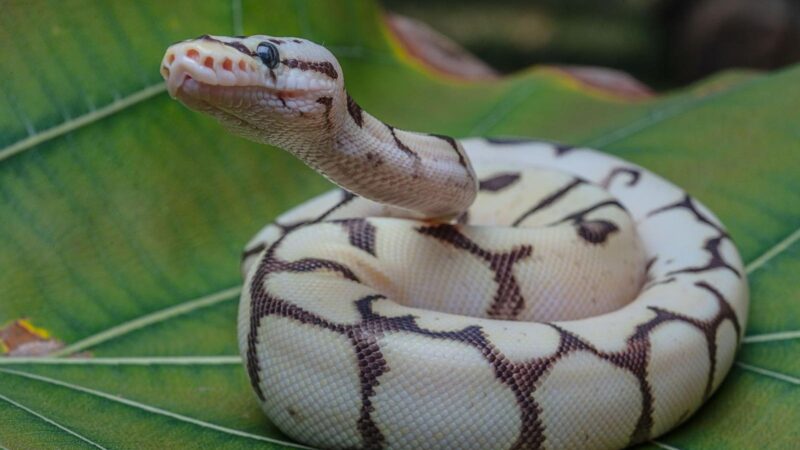There are thousands of snake species in the world, and most are non-venomous. Here are the ones reptile enthusiasts are most likely to take as a pet.
getty
More than 4,200 species of snakes exist on the planet and most are not dangerously venomous. So, which do humans tend to have as pets?
A good benchmark for what’s popular in the reptile pet community comes from 2021 research by José Valdez, published in Animals, that took advantage of Google Trends data between 2004 and 2020 and an internet survey to compare relative interest in reptiles.
Valdez’s research shows that the most searched-for snakes are ball pythons, corn snakes, boa constrictors and kingsnakes.
Here’s a herpetologist’s take on the “most popular” pet snakes.
1. Ball Python (Python regius)
The ball python (also referred to as the royal python) frequently ranks at or near the top in hobbyist surveys. Estimates place more than 1 million ball pythons in captivity and zoological collections.
From both a biology and husbandry perspective, ball pythons have some appealing attributes. In terms of their size and temperament, they are moderate in size (commonly 3–5 ft in adult length) and captive-born individuals possess a generally docile nature.
They also possess extensive morph diversity. There is a healthy “morph” market for genetic color and pattern variation that drives collector demand.
Many ball pythons in trade are also captive-bred rather than wild-collected, reducing pressure on wild populations (though wild-caught specimens persist).
However, a recent review of ball python trade in North America and Europe found that many breeders and vendors provide substandard housing (e.g., cramped rack systems, lack of environmental complexity) and insufficient husbandry guidance to purchasers.
It’s also important to bear in mind research bias and gaps in the literature, which is biased toward physical health; relatively few studies rigorously explore mental/behavioral welfare, especially in trade and transport stages.
Ball pythons are also more prone than some colubrids to intermittent fasting (“hunger strikes”), particularly under suboptimal conditions.
If a potential keeper opts for a ball python, I advise insisting on a breeder or source that documents proper enclosure size, temperature and humidity gradients, hides and feeding protocols. Expect a long-term commitment, as ball pythons can live up to 15 to 25+ years in good care.
2. Corn Snake (Pantherophis guttatus)
Corn snakes are one of the classic beginner-friendly pet snakes. In Valdez’s Google Trends list, corn snakes are also ranked in the top ten reptiles. Advertisements for corn snakes are also frequently recorded in reptile trade listings.
From a herpetological standpoint, they display hardiness. They adapt well to captive life and readily accept thawed frozen prey and have lower humidity demands than tropical species.
Adults typically reach 3–5 ft in size, which is manageable for many hobbyists. In terms of behavior, they tend to be calm and exploratory, but not aggressive.
Still, no species is without risk. One published case documented food-borne salmonellosis in a corn snake following a feeder-mouse meal, highlighting that zoonotic risks exist (though rare and preventable).
In my estimation, corn snakes are excellent choices for first-time keepers, so long as prospective owners adhere to quarantines, hygiene and careful sourcing.
3. Boa Constrictor (Boa constrictor)
Boa constrictors enjoy a strong presence in the exotic pet trade, partly due to their size, iconic appearance and captive breeding availability. In the Valdez ranking, boa constrictors rank behind corn snakes and ahead of some other snake taxa. A machine‑vision snake identification study also flags boa constrictor as among the more reliably recognized species, which is indicative of its prominence and distinctive form.
Biologically, boas present interesting tradeoffs. Boas are large and muscular, with significant energetic and enclosure demands. In terms of temperament, many boas are placid and tolerate handling, but individual temperament can vary significantly. They also tend to require a gradient of temperature, humidity and structural enrichment (climbing branches, hides) to thrive.
From the perspective of a herpetologist, boas are not beginner snakes. They demand more space, more vigilance in health monitoring and a commitment to secure enclosures and proper nutrition.
4. Kingsnake (Genus Lampropeltis And Others)
The “kingsnake” group includes several species and morphs, with widespread appeal because of their striking banding or coloration, moderate size and interesting natural behaviors (e.g. they sometimes prey on other snakes).
From the herpetological viewpoint, they are remarkable for their species richness, color variation and adaptability to different environments. Kingsnakes vary in size, temperament and ecological niche; some are more arboreal or secretive than others.
Some keepers report that kingsnakes can be “bitey;” not typically dangerous, but more reactive under handling.
Although they are generally adaptable to a variety of captive conditions, proper hiding spots, humidity and gradient temperatures remain essential.
For someone choosing among popular pet snakes, kingsnakes might suit someone who wants a little more behavioral character, as long as they accept occasional defensiveness. Always research the specific species or subspecies before you make your choice.
Advice For Choosing A Pet Snake
- Match the species to your commitment level. Corn snakes and certain kingsnakes tend toward lower-maintenance care and forgiving temperaments, making them suitable choices for novices. Ball pythons require more attention to environmental subtlety; boas escalate demands further.
- Source matters. Always prefer captive-bred over wild-caught specimens. This generally reduces stress, disease risk and wild population impacts. Vet any seller for enclosure photos, husbandry history and health assurances.
- Prioritize welfare, not aesthetics. A morph or rare pattern may be tempting, but optimal welfare (correct space, temperature, humidity, enrichment, quiet hiding) should be non-negotiable. Even popular species can suffer when poorly maintained, and this is well-documented in ball python trade analyses.
- Expect a long-term relationship. Many pet snakes live 15 to 25+ years with proper care. Choose a species you’re comfortable living with for decades.
- Understand risks and zoonoses. While these snakes are generally safe, pathogens like Salmonella are documented. Rigor in hygiene, for hands, prey handling and enclosure cleaning is essential.
- Prepare for feeding quirks. Some species (notably ball pythons) may undergo intermittent fasting. Prospective owners should monitor weight and adjust prey schedules accordingly. In contrast, corn snakes tend to feed more reliably under stable conditions.
- Plan enclosure and husbandry first, acquire the snake second. No snake prospers in a poorly prepared habitat. Getting the right cage, substrate, hides, heating and humidity control and security is more critical than acquiring a morph.
While many snake species are biologically fascinating, the trade and hobbyist world tend to converge on a handful of reliable, manageable taxa. Each brings tradeoffs in size, temperament, care needs and long-term maintenance.
For the discerning keeper, knowledge of biology and careful sourcing are your strongest tools. I encourage anyone entering the hobby to place welfare and realism above novelty, and to continue learning decades into your snake‑keeping journey.
Are you an animal lover who owns a pet, perhaps even a pet reptile? Take the science-backed Pet Personality Test to see how well you know your little friend.









